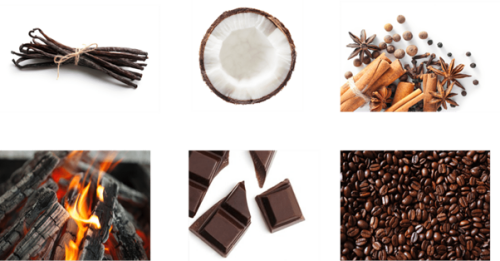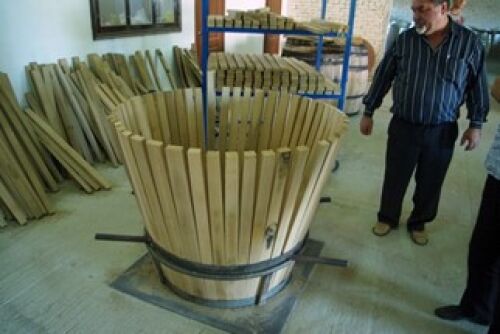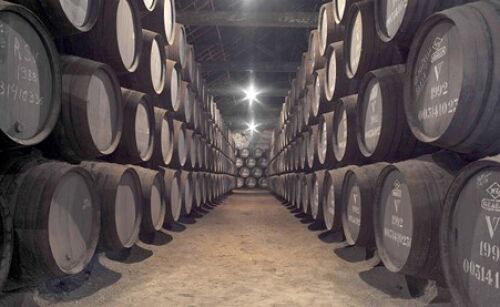Why is oak so associated with so many wines and is it always a good thing? Plus “The Chardonnay Conundrum”!
by Nick Adams MW
In discussing wine, the role and flavours of oak are as often talked about as much as the grapes behind the wines. Today, the role of oak in wine has become a much more topical issue – many wine drinkers adore the smells and flavours that oak can impart to a wine – whilst others are less sure.
Historically when making and storing (and transporting) wine there were only two natural products available - clay (amphora) jars, and wood. Winemakers in the early days then noticed that wood not only acted as a storage vessel but over time certain woods - eg oak - imparted interesting aromas and flavours to the wine too.
Skip forward a few centuries and today wood’s impact and contribution to wines’ styles is in some cases essential; whilst in others an anathema - why is this so and I will showcase some Peter Graham Wines where oak adds real value, and others where is completely unnecessary.
Image Right - Some classic smells and flavours associated with wood (oak) - from top left - vanilla, coconut, spices, coffee, cocoa, smoke or toast.

What Does Oak Do to a Wine?
Oak barrels can assist in winemaking to affect the colour, produce additional aromas and flavours, change the tannic profile of red wine, and expose the wine to controlled levels of oxygen as part of the production and aging process. By contrast hermetically sealed stainless-steel tanks are completely neutral and anaerobic.
Oak barrels are porous, which allows for a low level of evaporation and controlled oxidative reactions to occur, but at levels which do not spoil the wine or, in the short term, physically oxidise it. This also allows for secondary aroma and flavour elements to develop and in the case of red wines gently oxidise and soften the more aggressive tannins present from the skins of the grapes.
The chemical properties of the oak itself affect the wine. Phenols within the wood interact to produce vanilla (vanillin) notes to give an example. The degree of "toasting" in the construction of the barrel imparts – not unnaturally – smoky or toasty notes and if highly toasted can increase the density of the colour.
So, when your winemaker places their order for new barrels, they have the choice of 3 boxes to tick:
- High Toast
- Medium Toast
- Low Toast
Of course, you can always order and use all three which opens more options for blending the finished wine.
Wood itself contains tannins and these can dissolve into the wine and assist in the overall anti-oxidative properties for when the wine goes into bottle.
White wines fermented and aged in oak (classically Chardonnay) will not only adopt oak aromas and flavours but become much more “textural” on the palate. Also, the oak itself may impart a small level of dissolved wood tannins into the wine to enhance its structure. Again, as per a red wine, the toast level will impact on the colour and aromas if high with smoky and spicy notes.
Of course, the longer wine spends in contact with the oak barrel the stronger its influence will be. If the wood is also brand new and the cask small (in relation to the volume of wine, it holds) - typically 225-228lt - the oak intensity levels will also subsequently rise. But this must always be and remain in balance – an over-oaked wine will be just that – all oak and woody notes. So many winemakers talk about the oak element being in “the background, or the framework”, to their wine. In addition, the more delicate a grape variety intrinsically is, the less oak it needs before if overrides the subtle nuances of the grape. A good example of this is with Pinot Noir (eg Red Burgundy). Of course, vice-versa, for “bigger” varieties such as Cabernet Sauvignon (eg Left Bank Bordeaux).
Image Left - The making of an oak barrel - no nails or adhesives used just the incredible skill of the cooper who uses water and flame to bend and bind the staves together - hence the charring effect on the inside which gives you that toasty element.

The Most Important Types of Oak Used
As said the main wood used in the world of wine is oak, but oak itself comes in different forms and influences. The two most popularly used species are French and American oak. American oak has a much bolder vanilla note than French for example, so is popular with certain producers who see that attribute as being part of their style – classically many Rioja producers. French oak is more subtle so producers who want delicate, or background oak notes will favour this species.
But it is Not Always About “Oaky” Flavours – the important role that barrels play in maturing wine
And for certain wines - where the impact of prolonged but controlled oxidation is vital to the style - then the (oak) barrel becomes a very important mildly porous storage vessel in creating that environment to achieve the result. This is essential in the production of many of the great fortified wines of the world. Classic example here include:
- Sherry – Fino, Amontillado, and Oloroso styles (7-20 years +)
- Madeira – nearly all styles (3-20 years+)
- Reserve Tawny Ports – eg 10,20,30,40 year old cask aged examples
- Australian Rutherglen Liqueur Muscats (3-50 years+)
Image right - Graham Old Tawny Ports aging in Barrel
In these instances, the flavour or aromas of the wood become almost irrelevant as the focus in on creating an environment for producing tertiary aromas and flavours, rather than any secondary or woody notes from the container itself.
In practice with regards to winemaking the lifespan of a barrel is about 5 years maximum before all the benefits and flavours have become use up or leached. After that it in effect becomes a storage vessel and/or for prolonged oxidative aging.
And barrels don’t come cheaply. Highly prized, top quality French oak barrels can cost upwards of €750! But there are other options for lower priced wines and those who want a touch of oak but not too much, these include just using the staves themselves in a vat of wine or oak chips. At around €8 per kg, they offer a highly efficient and cost-effective way to do this, but obviously cannot replicate the intensity and polish which a barrel can deliver.

Where Oak Doesn’t Work – or is Actively Avoided
By contrast, wines where all the character and quality is about the intrinsic and exuberant flavours and aromas of the grape – eg the aromatic varieties such as Sauvignon Blanc (with a few exceptions), Riesling, Muscat, Gewurztraminer, Torrontés, Albariño - the role of (new) oak becomes irrelevant, and stainless steel the clearly preferred container option.
To take Riesling as an example the toasty and vanillin notes – if used – would be in direct conflict with the sheer exuberance, aromatic purity, and overt fruitiness inherently found, and enjoyed, in this grape variety.
And many easy drinking red and white wines avoid oak both for stylistic reasons and cost of course. And when red wines are naturally low in tannins – and very fruity in nature – these too tend to avoid any oak contact – and for the better. Classic examples of these would be Beaujolais (Gamay grape) and straight Valpolicella (Cortese).
Many indigenous Italian white varietals are also much better off when unoaked – in fact oak in Italian whites (apart from Chardonnay) is generally eschewed. Examples include:
- Gavi (Cortese)
- Soave (Garganega)
- Verdicchio (Verdicchio)
Finally, most Rosé wines are unoaked as producers want to showcase the exuberant fruity nature and primary aromatics of these wines.
Stylistic Choices – The Chardonnay Conundrum
A proportion of wine lovers have said that they do not particularly like Chardonnay – and I sometimes believe it’s because of the style in which this grape has been made rather than necessarily the grape itself. As mentioned earlier the majority of Chardonnay of the world are barrel fermented and lees aged producing a richer and much more textural style.
But there are Chardonnays made where oak plays little or no part in the styling of the wine – the most famous of which is Chablis. Most Chablis at Village level is unoaked – and again all the better for it. In addition, because the growing area is relatively cool there is a crispness and vitality to the wines which is very appealing, and I would encourage “nonlovers” of Chardonnay to try this style comparison and see it the issue for you is the use of oak – not the grape?
Try these two wines out below to see what I mean – one a classic, unoaked, cool climate Chablis from renowned producer William Fèvre – the other a measured barrel fermented New World example from Heggies in the cooler climate Eden Valley South Australia.
Oaked & Unoaked
In Summary
But for most red wines in the world, most aged, fortified wines, and most Chardonnay (oak) barrels are, and will remain, a vital part of the quality, style, maturation, and flavour of the product. Overall, the role of the wooden barrel has come on dramatically from the early days of just being a purely practical fermenting and storage vessel. Oak has become a mainstay in both the chemistry of making and then aging of wine as well as a flavour and aroma contributor. Today, I believe oak is being used more sensitively and empathetically in wine production and aging in general which I think can only be a good thing for the winemaker and drinker.
Peter Graham Wines Selection
Let’s finish with some wines which illustrate the role and use of oak well – and in different formats and guises. And then those where the avoidance of oak is for the better.
A classic modern favourite from the south of France – Picpoul de Pinet – which is all the better for being unoaked. Likewise, the Allan Scott Marlborough New Zealand Riesling showcases precisely why this grape should be left in its unbridled exuberant best. By contrast, the Ontanon white Rioja made from the richer Viura grape shows why this grape works well and in partnership with oak when barrel fermented and aged. Here the texture of the wine is as important as its core fruit flavours.
Whites
And now two contrasting reds – a classic Fleurie Cru Beaujolais where the Gamay grape expresses its primary nature at its best without any oak; but where the vanilla and coconut notes of the Reserva Cerro Anon Rioja compliment the strawberry jam notes and savoury texture of this wine.
Reds
Finally, a classic example of where the extended oxidative aging in oak has transformed this Graham’s 10 year Tawny into a lovely, savoury and more-ish wine where the oak is firmly in the background in flavour but essential in terms of production. Serve this chilled and into the summer!


